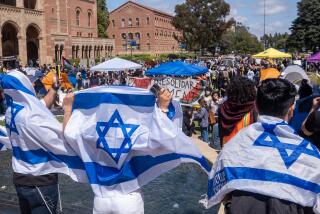University of Texas Seeks Diversity
- Share via
AUSTIN, Texas — It’s the little things that make Brandelyn Franks feel uncomfortable at the University of Texas at Austin:
Walking into a class of 400 students and being the only black person. Getting sideways glances from teachers and classmates when something racially controversial is said. Seeing the same few people at every diversity forum.
“I don’t necessarily think that the university is very inviting, although they try to make like they are,” said the 21-year-old history major, who’s in her fourth of five years.
President Larry R. Faulkner last year called for changes to make the state’s flagship university a more welcoming place for students of color. He created the position of “vice provost for inclusion and cross-cultural effectiveness,” to which Gregory J. Vincent was appointed in May.
Vincent is working to attract minority students and professors and make them feel welcome.
Vincent knows that could be a challenge at the school, where 17% of its 50,000 students are African-American or Latino, where vandals egged a Martin Luther King Jr. statue and where fraternities in recent years held parties depicting blacks in Jim Crow stereotypes.
He blames a number of factors for the relatively low proportion of African-Americans and Latinos, including a 1996 court ruling that struck down affirmative action in Texas for several years. He also cites the school’s segregationist past, which he calls the “legacy of exclusion.”
“There are some communities in Texas where UT is not seen as a completely open door,” Vincent said. “I think we’re doing some very tangible things to change that, but unfortunately that [perception is] still the case.”
Among Vincent’s first priorities is breaking down real and perceived barriers that discourage minority teenagers from applying.
“I want to make this a place of aspiration ... a place where students want to come as opposed to a place where there’s this feeling like maybe, ‘Is this place for me?’ ” he said.
Sean Watkins, a 2004 graduate with a degree in African American studies and history, said Vincent will have to persuade black and Latino teens that the university is interested in giving them a world-class education, not just in boosting minority enrollment.
“While they may have good intentions ... they need to make sure that the way they communicate that is positive or proper,” said Watkins, who ministers to students as a staff member for a campus religious group called InterVarsity Christian Fellowship.
Take the statues of Robert E. Lee, Jefferson Davis and other prominent Confederate figures that are displayed on the South Mall, a prime gathering place for students.
“What does that say to your African American students?” Watkins said. “These men fought to make sure I would not be a student at this university, that I would remain a slave.”
A panel of students, faculty and staff that Faulkner assembled to study racial tensions at the university has recommended moving the statues to another location on campus.
Omar Ochoa, the first Latino to serve as the student body president, acknowledged problems but said he was confident changes could be made. “In no way do I want this university to be pictured or painted as an overtly racist organization, because I don’t think that’s what it is,” he said.
Ochoa said administrators should back up their verbal commitment to diversity by requiring undergraduates to take courses in multiculturalism. The course requirement and the creation of Vincent’s job were among dozens of recommendations by the panel Faulkner created.
The campus might become more diverse now that the university is once again considering race in admissions decisions. In 2003, the U.S. Supreme Court ruled that race could be a factor in the process as long as it wasn’t the only factor.
More to Read
Sign up for Essential California
The most important California stories and recommendations in your inbox every morning.
You may occasionally receive promotional content from the Los Angeles Times.










